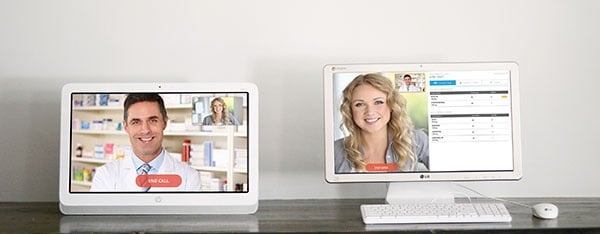Telepharmacy — much like the term "telehealth" — has become a popular buzzword in everyday healthcare chatter, from community pharmacy to clinics and health systems. Chances are you’ve heard of it, but don’t fully understand the concept and why it makes sense in today’s competitive pharmacy market.

So what is telepharmacy? How does telepharmacy work? Let's start simple.
The definition of telepharmacy
Telepharmacy is defined as, "the provision of pharmaceutical care through the use of telecommunications and information technologies to patients at a distance," according to the National Association of Boards of Pharmacy.
This broad definition of telepharmacy has many different applications. There are four different types of telepharmacy:
- Remote dispensing (retail/outpatient/discharge)
- Remote patient counseling (video counseling)
- Remote order-entry review (inpatient)
- IV admixture verification
More about telepharmacy
When telepharmacy first appeared in the early 2000s, the concept was centered around a single video link between a technician and pharmacist. New-age telepharmacy programs, like TelePharm, incorporate an imaged-based workflow (which enables the remote verification of prescriptions) and patient counseling through a secure, high-definition live-video connection. In terms of the four different types of telepharmacy, we partake specifically in remote dispensing (retail/outpatient) and remote patient counseling.
The ability to connect any pharmacist to any pharmacy offers patients in rural communities access to the professional care they would otherwise not receive. With that said, "Does telepharmacy provide the same quality care you're used to at a traditional pharmacy?" According to Dr. Charles Peterson, Dean of the North Dakota College of Pharmacy and pioneer of the North Dakota Telepharmacy Project, the answer is yes.
“Telepharmacy services produce the same quality as the traditional mode of delivery and provide some value-added features that are not found in traditional pharmacy practice."
- Dr. Charles Peterson, Dean of the North Dakota College of Pharmacy, ND Telepharmacy Project
Additionally, telepharmacy is a safe practice of pharmacy and has been proven to have a lower dispensing error rate than traditional pharmacies according to the NDSU telepharmacy project.
"Telepharmacies' error rate is less than 1 percent, a 50 percent improvement over traditional practice and half the national average."
- U.S. Department of Health and Human Services
Telepharmacy is feasible in community pharmacies, hospitals, health systems and clinics, nursing homes and other medical-care centers. But before we dive into different applications for telepharmacy, let's look at how telepharmacy works.
We have two different ways you can learn about how telepharmacy works. You can read our most popular blog article titled, "How Telepharmacy Works: 4 Simple Steps," or you can learn how telepharmacy works by watching a video.
Want to learn even more about telepharmacy? Visit our Learn page for more!

